Hoffman Triangle – Section 3
Hi! In my video I made a story about the Hoffman Triangle to show how a child would feel, as well as some possibilities for improvement. This is a neighborhood with many vacant lots and lots of opportunity to grow. I got a lot of great feedback from this video and I plan on making improvements to make it the most informative and helpful video as it can possibly be. I am going to look more into the community aspect and how they feel about the space. Therefore, I can make the best judgment possible to improve based on what the community needs. I want the community to able to come together and be happy with the final product and something they can be proud of. Also, because this is a child-based project, I want everything to be accessible for children and design, so they won’t be scared walking around in the community. There are many great qualities in this neighborhood, and I want to express that and show everyone what makes this place in New Orleans unique. I hope you enjoy this video and the next one to come.
Incheon, Korea
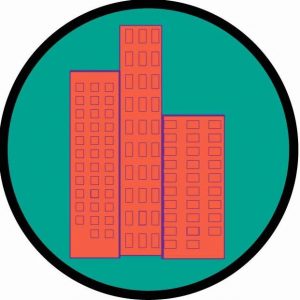 What makes Incheon, Korea a great child friendly city?
What makes Incheon, Korea a great child friendly city?
Incheon, Korea is a great example of a child friendly city for many reasons. First of all they take value in education and they want every kid to have the opportunity to go to school and hopefully decrease the poverty rates. They are always trying to find innovative ways to include kids and use the information that they get to improve their city to make it more inclusive for them. South Korea as a country was one of the original pilot studies for UNICEF because of how much they value their children. They are thought as being the future of Korea and want them to have a strong development.
Projects for helping children and their safety
The city starting in 2015 initiated a project called Safe Nuri (Safe World). This project was created to support children in need who did not have a safe living environment. Chevron has been developing ways to promote safety for kids when they are on the street and not at home. They help train the kids to use safety tools and where to go to find help in certain scenarios. It was a huge success from the start and continues to this day.
Incheon, Korea is considered one of the safest cities in the world. The crime in the city is not seen often, and to add to that, they say that generally if you accidentally leave your phone on a table, nobody will take it. Now that is saying a lot about children in the city too. There are many security cameras facing all directions that the city specifically did to slow down crime rates (you are always being watched).
Sustainable development Project
There has been a great movement for Korea to have more affordable housing though out the county and Incheon is trying to follow through with that. The goal was to have this done in the year 2030, but they still have a long way to go to fulfill that. This will provide homes for younger family to start their lives and in time, hopefully grow the population of the city. The Government is more focused right now towards LGBT rights and what they can do to help with the changes, so this is kind of on stand-by right now. This is also going to create more jobs for the city and more opportunities to grow with children. One of their main goals is to design it in a way that the future will be safe in these neighborhoods without much gentrification. Korea values anyone’s background and is open to trying new things.
Using urban design to improve road safety
The problem with urban roads is that they are generally very unsafe and scary sometimes especially for kids. Kids use streets in multiple ways, walking, biking, playing and traveling in cars. But the problem is that they are very vulnerable because they are hard to see. It is very important to make sure vehicles can see children and it is very big problem to address because slowing down doesn’t help all the time. Incheon continues a project that started in Seoul that cut traffic deaths by 95 percent between the years 1988 (1,766 deaths), to only 83 in 2012. The reason why this was so successful was because they created safe routes just for kids that directed them straight to and from school. They established a school zone area to the slow down cars and make them more away of their surroundings. A city designed for children must be safe for them too, and that’s what they are focusing on. Plus, the car accidents dropped by 32 percent as well in those areas. This project couldn’t have been done without great leadership and people who agree that this is important because the infrastructure needed to change for this to be built.
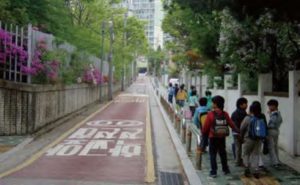
The layout of the city
The layout of the city is very similar to that of western Europe. There are many “V” cuts in the roads and everything is fairly easy to get to. The buildings in this area of the city are high rises and buildings now smaller than 6 stories tall. A high concentration of people live is this area and there are many convenient stores and other necessities. The middle of the map has smaller buildings, and the outside ring are all of the high-rises. Children can easily get from one place to another because there are a lot of large gaps between buildings for them to feel safe walking through. In the middle there are many small square shapes apartment and multi-use buildings. The large shapes in the middle are actually a grouping of smaller ones. This area includes, churches, transit, some schools, and grocery stores. In street view from google maps you can see that most of the streets are kept clean and taken care of. This is important for kids living in these communities for them to feel safe. Most of the streets in these dense neighborhoods are one way streets, and are often full of traffic. Kids will have to be careful crossing streets, but the crossing guards and lights help with that. The city is not set up like a grid, so instead the city was designed to have the roads go at different angles (which can be good in some circumstances) because the grid system wasn’t adopted until North America was colonized.
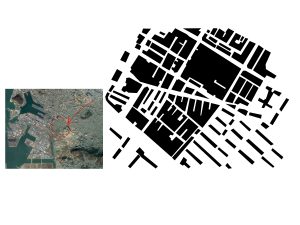
![]() Population of Incheon by age group
Population of Incheon by age group
The city has a fairly consistent percentage for its age’s population. When looking at children specifically, in 2018, 13.21% of them were 0-14 years of age. This number is relatively the average other than the 25-54-year olds being at a high of 45.5 percent. They are trying to increase their population by 500,000 people, but they are not having the best of luck so far. There total population as of 2018 was 2.9 million people and it is slowly dropping. They are projecting the population in 2030 to be 2.7 million.
What kids like to do In Incheon?
Incheon has a lot of fun, open spaces for kids to enjoy that are very interactive and inclusive for all age groups. Central Park Songdo is the most popular park in Incheon with a lot of open space and climbable play sets. Most of the time you will see kids outside and enjoying the weather while playing. This is also a pedestrian friendly city with walkways and bicycle lanes going throughout most of the city, this creates a safe environment for the kids and provides more protection. The mayor Park Nam-Chun even prefers pedestrians over cars to create a more livable environment. The children’s science museum was a recent project used to help expand the minds of the kids.

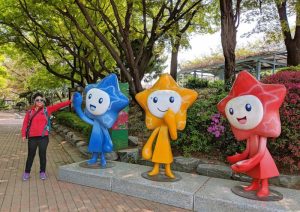
Kyoto, Japan
The climate of Kyoto
The climate of Kyoto if often very mind and humid during the spring and summer months. It is also rainy during the summertime because of its tropical location. The heat island effect contributes a lot to the temperature of the city. The maximum temperature that the city will reach it around 95 degrees Fahrenheit, and rarely exceeded 100 degrees. The nights are often very high in humidity, and monsoon season adds to that value. The winters are mild with highs over 50 degrees Fahrenheit. Their isn’t a lot of snow, just light flurries and cold rain.
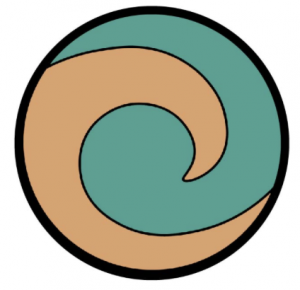 The threats that climate change has on Kyoto
The threats that climate change has on Kyoto
Kyoto is a coastal city on the west side of Japan has been around for 1200 years. The main problems that they encounter have to do hurricanes, and the aftereffects of flooding. Some other natural disasters that can happen there are typhoons and occasional earthquakes. Kyoto lies on two fault lines which is the Hanaore fault, and the Nara Basin Toen fault. When they have earthquakes, they are generally rather large ones because of the fact of the location of where the city sits.
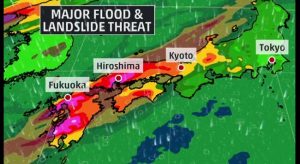
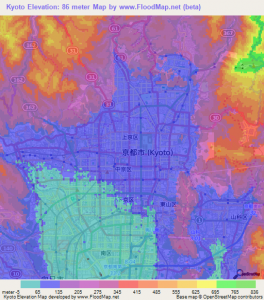
Natural disaster public awareness
Japan is prone to natural disasters and has over the years created an advanced warning system that is quick and informs the public. A problem that the old warning system had was to make people think that taking shelter in any infrastructure was safe (false sense of security), but in reality they were not. With the new warning system is can figure out where the best locations are to seek shelter. The improvement of this system has saved countless lives and the social aspect of the communities. In areas severely treated by natural disasters, some of the communities don’t partake in drills to prepare for flooding and major storm events, so Japan is trying to figure out ways to reach out to them and convince those communities that it is in their best benefit to do so. The graph below shows how prepared Japan is for natural disasters compared to other countries.
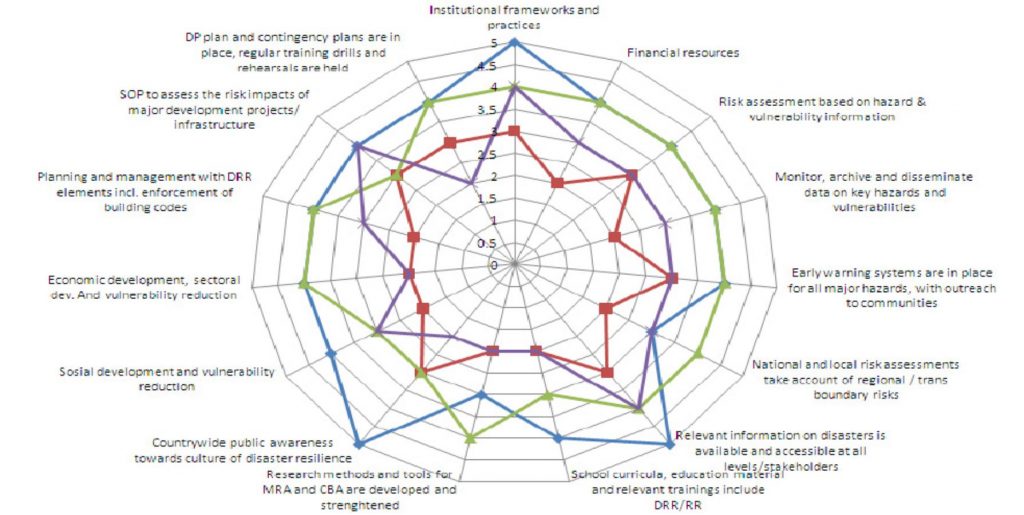
What steps are the city of Kyoto taking to mitigate?
The City of Kyoto Is proud of its history with dealing with these events. The government is implementing green economy and a city-wide collaboration in dealing with climate change. The country of Japan has always given financial support to all the cities that are in it. Every year Japan puts 500,000 dollars to the IDNDR Trust Fund, and this is to help specifically for any type of natural disaster. The Japan Disaster Relief Program (JDR) is a team funded by the government to go out into major disaster areas to do primarily search and rescue missions. They service Kyoto when these natural occurrences happen. (sources of funding)
Other fundraisers helping in Kyoto include:
Idro Japan (Accepts Volunteer and donates to the cause)
It’s Not Just Mud (A volunteer service for disaster relief)
Japanese Red Cross (Donates a good amount of money, and is always accepting volunteers)
Japan National Council of Social Welfare (Shows a list of organizations that contribute money and volunteers)
Donation for Western Japan Heavy Rain (Donations from Rakuten Points, credit card or bank transfers)
AAR Japan (Has emergency response teams ready and accept donations)
Yahoo! Japan (Collects donation which is sent directly to disaster relief programs)
Peace Winds Japan ((Has a Campfire Account (similar to GoFundMe) that goes directly to relevant municipal government))
Open Japan KEEN Matching Pay (Partnered with KEEN footwear to match all donations for a month. They already have volunteers on ground already)
Janic (Provides a list of organizations for disaster relief)
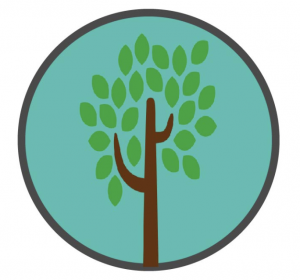 How Is the city adapting infrastructures to respond to climate change?
How Is the city adapting infrastructures to respond to climate change?
Kyoto is considered a pilot study project for Cities Alive and has a section talking about how they are making their buildings more resilient. The city is working on improving their water supply, sewage, and Storm Water management assets to keep the city moving. The 100 Resilient Cities website, they mention that they have 66 projects lined up as of 2016 to improve buildings and create greener infrastructure to use the water to their advantage. The Kyoto Protocol implemented UNFCCC, which is an organization to combat greenhouse gas going into our atmosphere. They plan on being completely free of building and vehicle emissions by the year 2050. It will surely be a challenge, but something they would really like to see done.
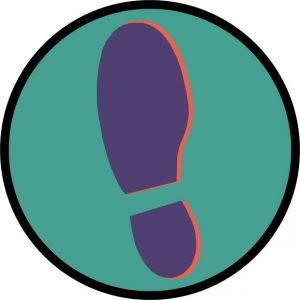 What is the Kyoto Protocol?
What is the Kyoto Protocol?
The Kyoto Protocol is an agreement signed by 128 nations around the world to help control climate change and their mission was to reduce greenhouse gasses by 5%. They are most concerned about the rising temperature and how it causes so many deaths worldwide from malaria, malnutrition, and diarrhea, which all together cause 3.5 million deaths a year from temperature and toxic rain changes. The Paris Agreement soon took place after this to continue this global challenge.

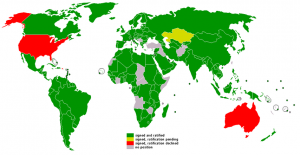
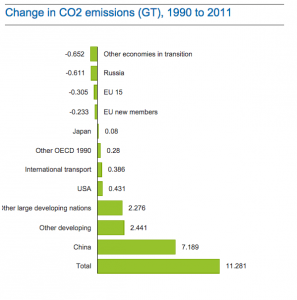
How are youth included?
The city is suffering from an aging population where there is a lack of middle age men and woman. So, it is up to the kids to figure out what they need in order to grow. Occasionally the planning committee has events for kids to participate by giving them ideas for what they can improve on. They strongly believe that the future lies with the kids. The Kyoto Protocol addresses this in its statement. They play a crucial role in helping improve the city with climate change in mind. The kids were asked to do a questionnaire-based pilot survey, and the scores were off the chart for what they knew about climate change. Among them; 66% were male, and 33.8% were females in different study areas. Now with these kids, in total 98.5% of the kids said through the survey that they believed climate change is real. Then 95.5% said human activities contribute to climate change as well. These are high numbers, and it means a whole lot that the kids are aware of this so that they can help make these good decisions and are educated enough on the matter. The youth are being educated all throughout their k-12 schooling, and it is a strong tool for combating destructive potential of climate change. The children can make a decision, and when they are older play a huge role in helping these changes come to life. With the declining age population that I said before, there are fewer people to support the economy, and to increase the power of reliance to overcome the climate issue. This was a recent issue that the Mayor, Daisaku Kadokawa addressed in March of 2019 at a climate change conference.